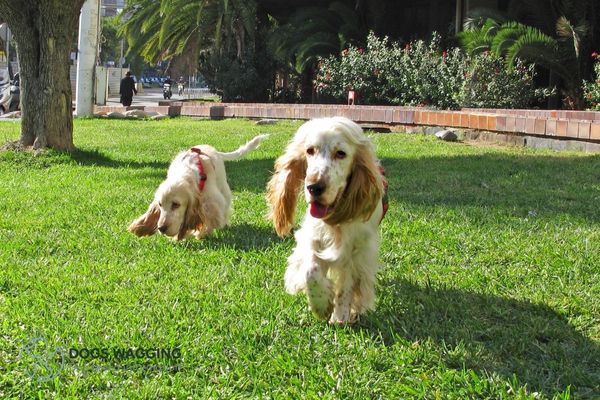John Switch • Thu Feb 29 2024
Why Dock A Cocker Spaniel Tail? - Read Before Docking

If you have ever observed Cockers with shortened tails or Spaniels without tails, you may have wondered about the reasoning behind docking a Cocker Spaniel Tail.
This procedure, which involves reducing a dog's tail either partially or completely for aesthetic purposes or to prevent potential harm, is known as tail docking. It is an outdated practice that involves cutting or crushing muscles, nerves, and bones in puppies under five days old without the use of anesthesia.
This tradition has been around for centuries, dating back to the time of the Roman Empire. Docking, which refers to the removal of all or part of a dog's tail, has raised questions about its purpose.
In this article, we will delve into the reasons and justifications behind tail docking. This blog provides information on cocker spaniels, tail docking, and why it may soon become a past thing.
> READ MORE:
- Cocker Spaniel Pitbull Mix: A Complete Guide And Pictures
What Is the Origin of Cocker Spaniel Tail Docking?
The practice of removing a portion of a dog's tail can be traced back to the Ancient Romans, who believed that cutting off the tail (and tongue) would prevent rabies.
In the 17th and 18th centuries, early American Puritans believed that dog tails were possessed by demons, leading them to cut off their tails.
During this time, in England, owners of hunting and gaming dogs were taxed, while those with working dogs on farms were not. As a result, working dogs' tails were docked to distinguish them from other dogs.
Over time, tail docking became more common as a way to protect dogs from getting their tails stepped on by larger animals. Hunters also believed that a shorter tail would prevent it from getting tangled in brush or grabbed by prey in the field.
Since 1881, the American Spaniel Club (ASC), which is the parent club of the Cocker Spaniel, has considered docked tails to be a customary practice. The ASC states that the reason for docking a Cocker's tail is because they are typically used for hunting, where they must quickly cover a large area of land and retrieve game on command.
The ASC also emphasizes the importance of training the Cocker to be under control at all times. Due to the breed's original purpose of hunting over 100 years ago, the Cocker Spaniel is traditionally docked.
The distinctive wagging of the tail while working in thick, dense cover, which can sometimes be deeper than the dog itself, makes docking necessary to prevent injury to the animal.
Why Is the Cocker Spaniel Tail Docked
One of the primary reasons for tail docking is to maintain the breed's standard. Many pet owners dock their long-haired dogs' tails to protect them from fecal matter.
In order to comply with AKC regulations, breeders of purebred dogs often resort to these surgical procedures. For almost a third of the breeds listed on the registry, which amounts to more than 60 breeds, tail docking is considered the norm by the AKC. Animal rights activists argue that the AKC's refusal to allow undocked dogs to participate in shows perpetuates this outdated practice.
Can a Cocker Spaniel Tail Be Docked Legally?
The act of tail docking is permitted in the United States but with certain conditions. The AVMA has provided a summary of these state laws and regulations on its website.
In contrast, tail docking is prohibited in the majority of countries, such as England and Wales, where it was outlawed in 2007, although there are some exceptions.
Additionally, numerous European and South American nations, as well as Iceland, Australia, New Zealand, and Israel, don't allow this practice.
Is Docking Harmful to Cocker Spaniel Puppies?
Those who carried out docking argue that puppies do not experience discomfort due to their underdeveloped nervous system. However, various studies have shown that both puppies and adult dogs have the same pain threshold.
The procedure is often performed without anesthesia, making it even more difficult for puppies to endure the intense pain. Docking involves severing connections between bones, cartilage, muscles, tendons, and up to seven pairs of highly sensitive nerves in a puppy's tail.
During the cutting and stitching process, puppies often emit loud cries, indicating their distress. As the wound heals, inflammation and tissue damage can also contribute to prolonged pain. Moreover, this unnecessary procedure carries a risk of infection and other complications.
Dangers Associated with Cocker Spaniel Tail Docking
Challenges with Movement
The dog's tail is composed of vertebrae and other essential tissues that help maintain its balance, functioning as an extension of its spine.
When a dog runs, turns, or performs certain movements, its tail acts as the rudder of a ship and is necessary for these actions.
Having a tail may have provided an evolutionary advantage for animals that require speed and agility, as seen in many species.
Cutting a dog's tail can have negative effects on its physical discomfort during the procedure, as well as post-operative locomotor issues, temperament, and neurobiological factors. Therefore, there are arguments against this practice.
Socializing Can Be Challenging for Some Individuals
Research has revealed that canines without tails are at a high risk of developing behavioral problems. This compensatory issue often causes them to be misunderstood by other dogs, putting them at a disadvantage.
A longer tail is more effective in conveying information among dogs compared to a shorter one. However, socializing your Cocker Spaniel puppy from a young age can solve this issue.
Another issue with docked tails in dogs is that it alters their appearance, making them frightening for children. It's hard to imagine our beloved furry companions not wagging their tails when they look at us or express happiness.
Post-Surgery Health Concerns
There is limited research available on the physical and emotional effects of tail docking on dogs, whether they are docked or not. Some studies have examined the potential consequences of this surgery in both the short and long term.
However, dogs undergoing tail docking may experience common problems such as excessive bleeding, infection, slow healing, and necrosis. The impact of neuromas, which are related to ongoing discomfort, remains uncertain.
Chronic Health Issues
There is a theory that dogs with docked tails may have underdeveloped pelvic muscles, but the evidence is not conclusive. Incontinence is more prevalent in dogs of docked breeds, but this could be attributed to factors other than docking. It is also plausible that other traits, such as docked tails, contribute to the increased incidence of incontinence in dogs of docked breeds.
Additional Issues
The importance given to tail docking in certain cultures may indirectly affect the well-being of animals, as it could lead to unqualified individuals performing the procedure when a veterinarian refuses or make it more difficult for dogs without docked tails to be adopted into good homes.
Taking Care of Your Docked Cocker Spaniel: Tips and Tricks
Caring for a cocker spaniel with docked tail requires a bit of extra attention and care. Here are some helpful tips to ensure your furry friend stays happy and healthy:
- Grooming: Regular grooming is essential for a docked cocker spaniel. Their fur can easily become matted, so it's important to brush them at least once a week. This will also help distribute natural oils and keep their coat shiny.
- Ear Care: Cocker spaniels are prone to ear infections, especially those with docked ears. Make sure to clean their ears regularly with a gentle ear cleaner recommended by your veterinarian.
- Exercise: Cocker spaniels are energetic dogs and require daily exercise to stay healthy. Take them for walks or play games that allow them to run and burn off excess energy.
- Diet: A well-balanced diet is crucial for your docked cocker spaniel's health. Consult with your vet to determine the best food for your dog based on their age, size, and activity level.
- Dental Care: Just like humans, dogs need regular dental care. Brush your dog's teeth at least three times a week to prevent plaque buildup and maintain good oral hygiene.
- Socialization: Cocker spaniels are social animals and thrive on human interaction. Make sure to spend quality time with your dog and expose them to different people and environments to prevent them from becoming anxious or aggressive.
- Health Checkups: Regular visits to the vet are necessary to monitor your dog's overall health and catch any potential issues early on.
By following these tips, you can ensure that your docked cocker spaniel remains happy, healthy, and well-cared for. Remember to always provide them with love, attention, and proper care to keep them thriving.
Reasons to Avoid Docking Your Cocker Spaniel Tail
- It is a painful and unnecessary procedure: Docking involves removing a portion of the puppy's tail without anesthesia, causing significant pain and discomfort.
- It can lead to health complications: The tail is an important part of a dog's anatomy. Therefore, removing it can result in issues such as nerve damage, infection, and chronic pain.
- It affects communication and body language: Dogs use their tails to communicate their emotions and intentions. Docking can hinder their ability to express themselves effectively, leading to misunderstandings and behavioral problems.
- It goes against breed standards: Many countries have banned tail docking for cosmetic purposes. It is unethical by major kennel clubs and breed associations.
- It does not benefit the dog: It is purely done for aesthetic reasons and has no medical justification.
- It is irreversible: Once a tail is docked, it cannot be undone. This means that the dog will live with the consequences of the procedure.
- There are alternative options: If you are curious about your Cocker Spaniel's long tail getting harmful or dirty, there are other ways to address these issues, such as regular grooming and training.
- It is illegal in many places: As mentioned earlier, several countries prohibit tail docking, and performing it could result in legal consequences.
- It is a personal choice: Ultimately, whether or not to dock your Cocker Spaniel tail is a personal decision. However, it is essential to consider the potential harm and lack of benefits before making a choice based on aesthetics alone.
We have discussed the major drawback of having a docked tail, which hinders communication and causes discomfort and pain. The movement of a dog's tail can convey important information to other dogs. It can indicate their friendliness or hostility.
What Are the Characteristics of Bobtail Cocker Spaniels?
The occurrence of bobtail cocker spaniels, who are born with naturally short tails, is a common sight. This is due to a significant genetic mutation that causes recessive traits. Bobtails can be found in all breeds and can be inherited from any bloodline. They closely resemble docked tails.
Breeding bobtail cocker spaniels with other bobtails is not encouraging as it can have negative consequences on the dog's well-being. If you are planning to breed your spaniel, it is crucial to confirm that their docked tail was a result of surgery. Usually, breeders will inform owners if a dog has a bobtail. However, it may be difficult to determine for a rescued dog.
Frequently Asked Questions - Cocker Spaniel Tail
Is Tail Docking Recommended for Cocker Spaniels?
Only a veterinarian makes a decision to dock a dog's tail. The dog must meet certain criteria to have its tail clipped, specifically for Welsh and English Cocker Spaniels, as they are the only breeds allowed to have their tails docked. This rule does not apply to any other breed or combination of breeds.
Is It Inhumane to Shorten a Dog's Tail?
It is undoubtedly harsh that dogs rely on their tails for communication. Dogs use their tails to maintain balance. The act of docking a dog's tail disrupts their ability to communicate with other dogs, leading to misunderstandings from others.
What Is the Reason for Docking the Tails of Working Cockers?
In England, it is permissible to dock the tails of spaniels, terriers, hunt point retrievers, or their mixed breeds as long as there is proof that they are likely to be used for work. If a service dog's owner or caretaker wishes to have its tail docked, they must ensure that it is legal.
What Is the Reason for Spaniels Having Their Tails Docked?
One of the main purposes of docking is to protect working dogs from potential injuries. Another frequent motive for breeders to dock spaniels' tails is to conform to the breed's standards in preparation for dog shows.
Why Do We Dock a Dog's Tail?
The original purpose of tail docking was to safeguard the tails of working puppies from potential injury. Owners of hunting dogs discovered that by removing the tip of the tail shortly after birth, adult dogs were less likely to harm their tails while on the job.
Conclusion
There is a common inquiry about whether Cocker Spaniels have tails. The answer is yes, they do. Their tail length is naturally present from birth, like any other regular dog.
Understandably, people may be vague about this, as many Spaniels have undergone tail shortening to conform to breed standards.
Some have also had their tails docked for safety during work or hunting. However, Cocker Spaniels possess tails. After considering the reasons Why Dock a Cocker Spaniel Tail? The decision to dock or not lies with the individual.

John Switch / Author
Hello this is a test author
Recent blog posts

John Switch • Thu Feb 22 2024
Akita Mix With Rottweiler: All Facts You Should Know
The Akita Mix With Rottweiler is a combination of purebred Akita and purebred Rottweiler. These dogs are very loyal, devoted, and intelligent. They require

John Switch • Fri Dec 29 2023
American Corgi: All Facts You Need to Know
An American Corgi are a mixed dog which is result of crossing two different breeds: the Cardigan and the Pembroke Welsh. Let's explore the allure of the Am

John Switch • Fri Feb 23 2024
All Things About Anatolian Shepherd: Traits, Health Cares
Do you want to know more about Anatolian Shepherd Dogs? They originated in Turkey, where they were bred to be protectors of shepherds' livestock. They are a

John Switch • Tue Feb 27 2024
Australian Cattle Dog Behavior Issues You Should Know
What are Australian Cattle Dog Behavior Issues? - Australian Cattle Dogs are famous for behavioral issues, such as destructive behavior, nuisance barking, d
 The origin of Cocker Spaniel Tail Docking
The origin of Cocker Spaniel Tail Docking The Cocker Spaniel Tail
The Cocker Spaniel Tail The cocker spaniel docked tail can cause challenges with movement
The cocker spaniel docked tail can cause challenges with movement Chronic Health Issues for Cocker Spaniel Docked Tail
Chronic Health Issues for Cocker Spaniel Docked Tail Taking Care of Your Docked Tail Cocker Spaniel
Taking Care of Your Docked Tail Cocker Spaniel